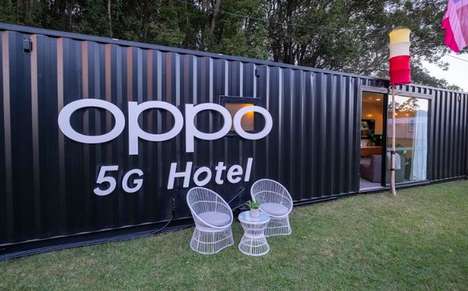Listening to Your Customers
An Interview with Doug Warner, Head of Business Innovation, Amazon Web Services (AWS)
Related Trend Reports
Tech An experienced leader with a data-driven and strategic mindset, Doug Warner is the Head of Business Innovation at Amazon Web Services (AWS). He is adept at incubating and managing businesses for startups and global enterprises, with experience in business strategy, financial planning, partnership development, and go-to-market execution. He also has a diverse background in management consulting, venture-backed startups, and high-growth technology to drive innovation and profitability.
An experienced leader with a data-driven and strategic mindset, Doug Warner is the Head of Business Innovation at Amazon Web Services (AWS). He is adept at incubating and managing businesses for startups and global enterprises, with experience in business strategy, financial planning, partnership development, and go-to-market execution. He also has a diverse background in management consulting, venture-backed startups, and high-growth technology to drive innovation and profitability.1. With continued uncertainty in the business world due to inflation, recession and supply chain issues, how has this changed your approach to innovation?
During chaotic times, many can view changes out there as negative. Or you can look at disruption and changes out there as an opportunity. Many top startup companies have emerged through highly disruptive downturns. A great example is Airbnb, and many others. They all arose out of highly disruptive, sort of downturns. Because when people are really comfortable and organizations are really comfortable, it's actually a lot harder to change. But when things are more on edge, more change comes in and more time is spent assessing your choice. Do I change a little bit around the things I already do? Or do I while I'm adjusting and pivoting? Do I also have more latitude to do some new things that I maybe wasn't thinking about? At Amazon – whether it's Amazon retailers, amazon.com or Amazon Web Services – we structure ourselves to drive innovation regardless of the times. We don't look at challenging economic changes per se, as changing our focus on long term offerings, and are all about starting with a customer and working backwards. And I'd say for innovation in general, if you're not trying to solve a need or a problem, find one and then solve it. It doesn't really matter, because that leads to so many other interesting conversations.
2. What are some of the key trends you're focused on from a personal perspective, as well as in terms of organizational goals?
On a personal level, I've been involved in innovation for many years, both before and during my time at Amazon. Before I was at Amazon, I was a Chief Innovation Officer for many years at Hewlett Packard. Innovation encompasses various areas, such as PCs, printers, 3D printing, biological tissue, and more. What I found is that innovation often comes from unexpected collisions and connections between seemingly unrelated elements. It is not a logical or linear process and involves examining different things in the world and finding synergies. I have an interesting story about that which may not be for everyone. It’s actually a video at a keynote I once gave, which is about nothing that actually goes on that’s new is actually new, and that it’s actually coming from the past and recombined. So whether it’s Apple and Steve Jobs introducing the first mouse which they didn’t invent or the WYSIWYG computer screen. Or more interestingly, when you look at the printing press, it’s one of the top 10 inventions of all time. It wasn't Gutenberg in 1400s Europe who invented it, but rather it was an invention that originated from human ingenuity. I believe this story will captivate many people.
Or more interestingly, how many people here think that the printing press is, let's say, one of the top 10 inventions of all time? Anybody? Okay. Right. So it was invented, once again, not by Gutenberg in the 1400s in Europe. Turns out that Gutenberg lived in a part of Germany, the Rhine River, which was sort of like the Paris of its day, where merchants would come and go from all over the world. One of those merchants happened to be Marco Polo, who not long before had come back from a journey in China. And in China, he discovered that they had Movable Type, these big block letters that you could stamp things with. At the same time, they were just uncovering Pompeii, but it had been buried in a volcanic explosion in Roman times, and they discovered the wine press where you can squish the grapes, and out would come the juice. What Gutenberg did was converge these ideas into one bigger concept. He thought, what if I take these block letters that Marco Polo brought back from China, and I take this wine press from France and the Roman Empire and I clip them together. So some of the greatest inventions of all time were already there right in front of people's eyes. They just couldn't put the pieces together to see what was what so that's one example.
On the personal front, I translate that into a focus on trying to take in experiences with different people, different parts of society, cultures, travel, in order to see the things that are the same between us and the things that are different in different fields of study even. From that come creative ideas.
As for Amazon and AWS, 90% of what Amazon makes and creates–whether it's something you use as an individual or something an enterprise or company uses—comes directly from suggestions we get from customers. The other 10% come from our insight into what customers don't necessarily want to say. We discern different exposures to customers, to gain ideas or kernels just like sitting on the Rhine River with Marco Polo.
3. Are there any outside industries that you look to, in terms of getting inspiration or borrowing new ideas?
Well, we cover most industries at Amazon and AWS–the original name of Amazon, came from certainly A to Z for everything. At AWS, we're in all of our customers’ industries which range from hospitality and travel to retail, healthcare and genomics, to finance and banking. And we do look at things going on across different industries to accommodate trends.
So not surprisingly, with COVID, we have world supply chain disruptions that affected human beings, services and pretty much everybody else. The supply chain was interrupted and that has created a tremendous emphasis on companies that are in line to figure out how to transform their resiliency in order to have a more robust supply chain, which starts with understanding what you have and where it is in any given moment. So visibility is crucial.
If you don't know the problem you're trying to solve, you actually solve the problem. So that's the first part. The flip side, which everyone will also hopefully relate to, is what we call customer 360. On the other side, what happened during the pandemic is that many brands who would traditionally sell their goods through e-commerce channels, have to do so in a new way. With everyone staying home during COVID, all of a sudden, all of these new channels came up, and now the things these companies need to do look very, very different. Now we can sit here and go, well I get it. That might be true if you make clothing, but it applies to healthcare, it applies to medicine and it applies to education. You pick an industry and there's going to be some consequence, so we look for those broader trends and try to break them down into their constituent parts. And then we look for ways to solve the problem for a constituent part, can we bring that as a solution to people independent of their industry so that they can better understand their situation. In AWS’ case, their own internal customers and then of course, creating something productive that makes sense.
4. What are some of the deliberate steps that you take to ensure that you avoid disruption, maintain market position and grow the business?
Well, that's an interesting question, because as broad as Amazon is, you know, many companies think about how they're going to do business out there and they think about competition. That's one way to do it and it works well for some, but that’s not how we do it. We like to say we're cooler and different. At Amazon, we literally have a phrase “we are customer obsessed and we are competitor aware.” So we are not competitor obsessed and customer aware. As a result, we don't start with the market generically, and we don't start with what are they doing? We start with what we're actually hearing from the customer, and then we work backwards from that point of view consistently whether times are good or not.
And that methodology that Amazon has codified into its culture, the way we practice our behaviors and mechanisms, and things we do gives it its competitive advantage. And I can give you some examples. We organize culturally, in a peculiar way that’s different from most. We have what we call the two pizza team concepts. The two pizza teams means any team that can be fed with two pizzas is too big. And so we have endless numbers of teams, and they all have to work together to get things done, but they stay small and they stay agile. Another example is that we set ourselves up structurally and architecturally to enable a do-it-yourself culture. And that means that we make all these capabilities available for others and we encourage people to build new things, and we support them in doing that. This means anyone at Amazon can create something new and they don't need to go for permission. I want you to think about that for a second. They don't need to go for permission.
Now, that doesn't mean they can scale it for the whole world without permission, but they can create something, and can get something going. At Amazon, it’s actually an expectation and if you’re not doing it, you're what we call meeting the bar. In order to be higher than the bar, you have to do unexpected things in expected ways.
5. Can you give us some insight into the major shifts that you anticipate influencing your industry in the next 1-3 years?
This is more my personal view because anyone who actually knows the answer to this question will be very, very wealthy. You can look around and see what's going on right now when it comes to different technologies. The whole AI thing like what’s going on with ChatGPT, that’s not new. It’s been around for a few years and it’s just now catching fire. ChatGPT essentially raised the awareness of the public as it jumped through the chasm, but essentially, what's really been going on more broadly is everything is digitalized, across the board. And with digitalization of aspects of our lives–whether it’s devices, aka autonomous cars, new things that are happening in biology or technology, we’re going through the sort of early stages of evolution of things in the physical world. We know this because it all started with email, and then it went into music, into movies, and now it’s going into everything from ovens to cars. And so it's really hard to predict how that’s going to change things. What we do know based on data is that it’s indicating a life cycle pattern, similar to generational shifts. The life cycle of Generation X is primarily determined by age, but social adoption seems to be happening at a faster pace, gradually shortening over time. Instead of spanning many years, it now occurs within decades or even shorter periods. So strap in because we're in for a very interesting couple years and a lot of that I say will depend on what happens in the economy
6. You spoke about giving employees permission to go for new ideas without being held back. Do you have any examples of notable innovations that have failed or progressed?
One of the biggest, best examples is the Fire Phone.The Amazon Fire Phone did not perform well in comparison to iPhones or Android phones. However, rather than punishing the organization, which initially started with just one or two people and evolved into an unforeseen financial burden, it utilized technologies that made it unique and different. The phone had a conversational and natural interface integrated into users' lives. This example illustrates one prominent instance of ongoing developments. Additionally, there is the story of a Solution Architect at Amazon who conceived an unprecedented idea. At Amazon, we don't use slides internally; instead, we rely on comprehensive FAQ documents that resemble press releases with accompanying FAQ sections. The goal is to ensure that someone unfamiliar with the topic can read it as a complete and understandable concept. Through multiple iterations and further exploration, significant progress can be achieved. In this particular case, the individual proposed the concept of enabling package delivery inside customers' homes by gaining their permission to open their garages. Through tinkering with hardware, addressing software challenges, and conducting a small pilot with collaborating individuals, this idea eventually transformed into Amazon's service of delivering packages directly into people's garages. It originated from a single idea and underwent continuous refinement without the need for extensive planning far in advance
7. What is your advice for future innovation leaders?
The quest for knowledge and understanding fuels my curiosity. To gain a better understanding of the world, I seek information from various sources and explore multiple avenues. One significant example that comes to mind is the future of education. During my time in school, I encountered numerous individuals from all over the world asking for guidance on what to study and how to prepare for the future. There were two prevalent perspectives: one emphasizing practicality and job market demands, while the other focused on a more hybrid approach. Personally, I advocated for a blend of both. This perspective stemmed from research that highlights the ever-changing landscape of jobs and the fact that certain professions may become obsolete over time. Instead of pursuing a singular path, I believe it is crucial to develop a solid foundation of skills while also cultivating critical thinking, problem-solving abilities, agility, resilience, and adaptability. Traditional education systems in North America, Europe, and Asia have historically emphasized producing individuals who can seamlessly fit into a production-oriented structure with clearly defined objectives. However, as we navigate a rapidly evolving world where boundaries between industries blur, new skills and approaches become indispensable.
References: aws.amazon


